Themed collection Removal of chromium from aqueous solutions

Recent advances in hexavalent chromium removal from aqueous solutions by adsorptive methods
Despite the extensive existence of adsorbents for Cr(VI) removal from aqueous solutions, new adsorbents and modification of existing adsorbing materials are continuously sought after.
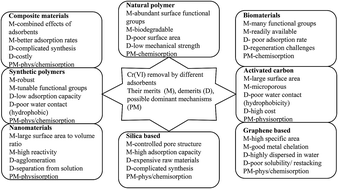
RSC Adv., 2019,9, 26142-26164
https://doi.org/10.1039/C9RA05188K
Synthesis and characterization of activated carbon from sugar beet residue for the adsorption of hexavalent chromium in aqueous solutions
A series of micro–mesoporous activated carbons (ACs) were prepared from sugar beet residue by a two-step method including KOH chemical activation and were used for Cr(VI) removal from aqueous solutions.

RSC Adv., 2021,11, 8025-8032
https://doi.org/10.1039/D0RA09644J
Self-assembly preparation of lignin–graphene oxide composite nanospheres for highly efficient Cr(VI) removal
Lignin/GO (LGNs) composite nanospheres were prepared by self-assembly method, which showed excellent adsorption performance for Cr(VI) removal.

RSC Adv., 2021,11, 4713-4722
https://doi.org/10.1039/D0RA09190A
Reduced graphene oxide supported ZnO quantum dots for visible light-induced simultaneous removal of tetracycline and hexavalent chromium
The photocatalytic mechanism explains that electrons and hydroxyl radicals were responsible for reduction of Cr(VI) and oxidation of tetracycline.
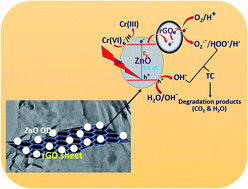
RSC Adv., 2020,10, 20494-20503
https://doi.org/10.1039/D0RA02062A
Insight into the synergistic effect on adsorption for Cr(VI) by a polypyrrole-based composite
Polypyrrole-based (PPy) composite are promising candidates for the treatment of water pollution.

RSC Adv., 2020,10, 8790-8799
https://doi.org/10.1039/C9RA08756G
Removal of chromium(VI) from polluted wastewater by chemical modification of silica gel with 4-acetyl-3-hydroxyaniline
Use of a newly synthesized Si-CPTS-AHAP adsorbent in the removal of Cr(VI) ions in wastewater treatment systems may potentially lead to low cost and highly efficient heavy metal removal.
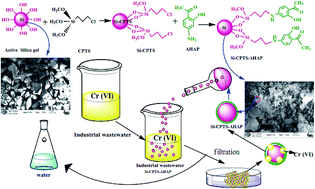
RSC Adv., 2019,9, 37403-37414
https://doi.org/10.1039/C9RA05810A
Insight into the adsorption mechanisms of methylene blue and chromium(III) from aqueous solution onto pomelo fruit peel
In this study, the biosorption mechanisms of methylene blue (MB) and Cr(III) onto pomelo peel collected from our local fruits are investigated by combining experimental analysis with ab initio simulations.

RSC Adv., 2019,9, 25847-25860
https://doi.org/10.1039/C9RA04296B
Efficient removal of hexavalent chromium from water by an adsorption–reduction mechanism with sandwiched nanocomposites
A sandwiched nanocomposite has been developed to remove hexavalent chromium ion Cr(VI) from water by an adsorption–reduction mechanism.

RSC Adv., 2018,8, 15087-15093
https://doi.org/10.1039/C8RA01805G
Polyethylenimine-functionalized cellulose aerogel beads for efficient dynamic removal of chromium(VI) from aqueous solution
Cellulose aerogel beads with high a density of reactive amino groups were facilely prepared via a cross-linking reaction for efficient dynamic removal of Cr(VI) from aqueous solutions.

RSC Adv., 2017,7, 54039-54052
https://doi.org/10.1039/C7RA09940A
Graphene oxide/Fe3O4/SO3H nanohybrid: a new adsorbent for adsorption and reduction of Cr(VI) from aqueous solutions
A sulfonated magnetic graphene oxide (SMGO) hybrid was successfully synthesized via the nucleophilic substitution reaction and characterized.
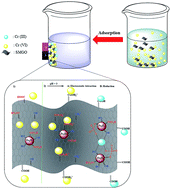
RSC Adv., 2017,7, 14876-14887
https://doi.org/10.1039/C7RA01536D
Facile synthesis of tea waste/Fe3O4 nanoparticle composite for hexavalent chromium removal from aqueous solution
A tea waste/Fe3O4 composite was prepared through chemical co-precipitation approach and was used for Cr(VI) removal, involving an adsorption-coupled reduction mechanism.

RSC Adv., 2017,7, 7576-7590
https://doi.org/10.1039/C6RA27781K
Magnetically recoverable ZrO2/Fe3O4/chitosan nanomaterials for enhanced sunlight driven photoreduction of carcinogenic Cr(VI) and dechlorination & mineralization of 4-chlorophenol from simulated waste water
In this laboratory-scale experiment we report the treatment of carcinogenic Cr(VI) and 4-chlorophenol by ferromagnetic ZrO2/Fe3O4 nano-heterojunctions supported on chitosan.

RSC Adv., 2016,6, 13251-13263
https://doi.org/10.1039/C5RA23372K
Effective removal of Cr(VI) using β-cyclodextrin–chitosan modified biochars with adsorption/reduction bifuctional roles
In this work, beta-cyclodextrin–chitosan modified walnut shell biochars (β-CCWB) were synthesized as a low-cost adsorbent for the removal of heavy metal Cr(VI) from aqueous solutions.
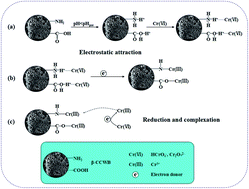
RSC Adv., 2016,6, 94-104
https://doi.org/10.1039/C5RA22886G
Adsorption of Cr(VI) onto a magnetic CoFe2O4/MgAl-LDH composite and mechanism study
Magnetic materials as adsorbents can provide effective removal and quickly separate pollutants in wastewater treatment.

RSC Adv., 2015,5, 49791-49801
https://doi.org/10.1039/C5RA06178D
Chitosan modification of magnetic biochar produced from Eichhornia crassipes for enhanced sorption of Cr(VI) from aqueous solution
In this research, chitosan modification of magnetic biochar (CMB) was successfully prepared for effective removal of Cr(VI).
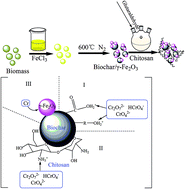
RSC Adv., 2015,5, 46955-46964
https://doi.org/10.1039/C5RA02388B
Effect of porous zinc–biochar nanocomposites on Cr(VI) adsorption from aqueous solution
A new synthesis method was developed to produce zinc–biochar nanocomposites from sugarcane bagasse.
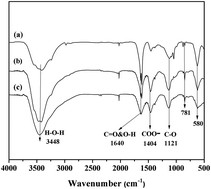
RSC Adv., 2015,5, 35107-35115
https://doi.org/10.1039/C5RA04416B
Removal of Cu2+, Pb2+ and Cr6+ from aqueous solutions using a chitosan/graphene oxide composite nanofibrous adsorbent
A novel electrospun chitosan/graphene oxide (GO) nanofibrous adsorbent was successfully developed by an electrospinning process.
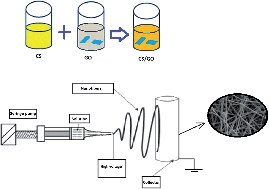
RSC Adv., 2015,5, 16532-16539
https://doi.org/10.1039/C5RA01500F
A simple one-pot synthesis of highly fluorescent nitrogen-doped graphene quantum dots for the detection of Cr(VI) in aqueous media
A simple one-pot massive synthesis of highly fluorescent nitrogen-doped graphene quantum dots for the detection of Cr(VI) in aqueous media was demonstrated.
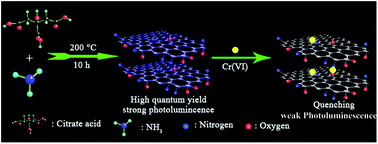
RSC Adv., 2014,4, 52016-52022
https://doi.org/10.1039/C4RA09320H
Polyaniline coating on carbon fiber fabrics for improved hexavalent chromium removal
Cr(VI) can be removed fast by PANI/CF with the reduction of Cr(VI) to Cr(III) by PANI.

RSC Adv., 2014,4, 29855-29865
https://doi.org/10.1039/C4RA01700E
Polyacrylonitrile/polyaniline core/shell nanofiber mat for removal of hexavalent chromium from aqueous solution: mechanism and applications
Polyacrylonitrile/polyaniline core/shell nanofiber was prepared, and the mechanism and applications for Cr(VI) adsorption was carefully discussed.

RSC Adv., 2013,3, 8978-8987
https://doi.org/10.1039/C3RA40616D
Magnetic polyaniline nanocomposites toward toxic hexavalent chromium removal
The behavior, mechanism and kinetics of toxic hexavalent chromium (Cr(VI)) removal by magnetic polyaniline nanocomposites from different pH solutions are reported.
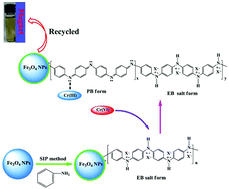
RSC Adv., 2012,2, 11007-11018
https://doi.org/10.1039/C2RA21991C
About this collection
We are very pleased to present our 10th Anniversary collection on Removal of chromium from aqueous solutions!
Looking back over the last 10 years, we would like to showcase some of the very best articles that have been published in RSC Advances. Many of these papers have been cited hundreds of times, providing valuable advances for further research, and some continue to be among the journal’s most downloaded articles as of today.
We hope you enjoy our 10th Anniversary collection on Removal of chromium from aqueous solutions!